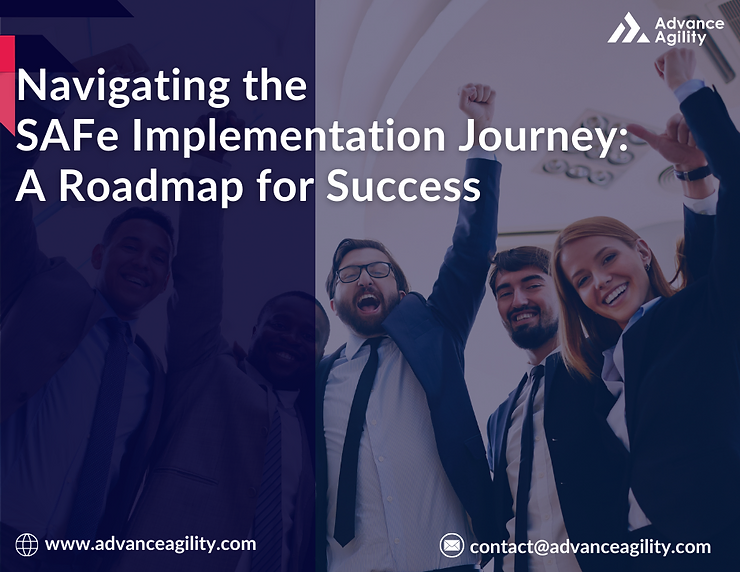
Navigating the SAFe Implementation Journey: A Roadmap for Success
Advance Agility
Scaled Agile Framework(SAFe) certification I Scrum Master Certification I Coaching I Consulting I Digital Transformation
Businesses failing to provide new solutions in a given time frame is the reason and could be a more straightforward case for a change. Regardless, before a SAFe adoption can happen, there must be some compelling reasons that trigger the need for a change. And if you are someone wondering how the SAFe Implementation roadmap can help organizations build a working plan to improve their business agility, then keep reading.
So, before we learn about the entire process of the SAFe Implementation roadmap, let’s start from the beginning stage where organizations realize the urgency for a change after failing to compete.
What are the Compelling Reasons for SAFe Implementation in Organizations?
If we thoroughly look at the official SAFe Implementation roadmap process, it all starts with the larger enterprises assuming that they won’t survive in the future. And the leaders of the organization must come up with a clear list of reasons that demands a change of methodology.
Some of the compelling reasons are:
1. Too many team members working together.
2. Lack of common vision.
3. Lack of collaboration.
4. Development is not in synchronization.
5. Unstructured dependencies create problems.
6. Multiple sources of requirements.
7. Agile teams are not working in cadence and so on.
How to Start Implementing the SAFe Framework in an Organization?
When the existing way of functioning isn’t adequate to address the needs of the end-users and the business is at a constant sense of failing to improve, it is convincing enough to say that the organization may need to do the additional hard work by switching to SAFe Implementation roadmap that includes the following steps:
Support from Senior Leadership
The first crucial step to implementing the SAFe methodology is by coming up with a ‘vision’ and changing the mindset of the people involved in the organization. A vision supported by the senior leadership team expresses their commitment to the change and can make a lot of improvement in the implementation process.
Reaching the Starting Point
After a vision or a common goal for the organization is confirmed, the shared experience of leaders and other experts who have attended Leading SAFe can establish an aligned and committed approach to achieving the change. They must examine the current system of working and learn the changing mindset and other practices that are helpful to envision the transformation that the organization is desiring to achieve in the future.
Transforming the Change Agents
After adopting new principles and practices for business agility, it is now time for building a powerful coalition. This team of change agents must contain the following qualities such as:
1. Ability to set the vision
2. Lead the way for other team members
3. Remove the impediments
4. They should be capable enough to implement specific changes
5. Sufficient organizational credibility
6. Expertise in making quick decisions
In most organizations, the certified SPCs are internally sourced from trusted consulting partners, business and technology leaders, project and portfolio managers, and individuals with organizational credibility.
In the second stage of the Implementation process, organizations can hire external coaches too to build their agile teams. The learning process for the team members begins with the Implementing SAFe certification classes. This helps organizations overcome common implementation mistakes. Candidates attending this four-day course can become efficient in identifying the Value Streams, ARTs, and Launch ARTs. They can also become competent enough to manage an Agile Portfolio.
领英推荐
Creating the LACE members
LACE which stands for Lean-agile Center of Excellence is a well-identified agile team responsible for facilitating the transformation, managing the transformation backlog, fostering Lean-Agile learning, coaching leadership, and supporting Lean Portfolio Management.
Training Programs for Managers and Leaders
The journey of building a powerful coalition ends in this stage where the organization invests in developing a strong leadership to handle the change in the organization successfully. Here the leaders are expected to improve their knowledge about the principles of the SAFe and reinforce its values. They will also learn to drive business agility, build a foundation with a change mindset, and building solutions with product delivery.
Leading the Transformation Using SAFe
In this stage of the roadmap, the SPCs who had attended the Implementing SAFe online Training will be helping members of the organizations develop the three dimensions of Lean-Agile Leadership. They can learn it through Dr. Kotter’s change accelerators which are closely aligned with the SAFe implementation roadmap that includes:
1. Creating a sense of urgency
2. Building a powerful coalition
3. Forming a vision
4. A need for a volunteer army
5. Removing impediments
6. Generating short-term goals
7. Acceleration and institute change
Identifying the Value Streams
The value streams are a series of steps used to produce a tangible result for the client. This is of two types:
1. Operational value streams: a line of activities performed to deliver a product or a service.
2. Development value streams: Activities involved in converting a business hypothesis into a solution that delivers customers value. For example, designing and developing a device.
Identifying the Value Streams can be done using a Value Stream and ART Identification toolkit that comes with SAFe. This toolkit comes with a proven, systematic approach that helps to understanding the value streams better.
Therefore, these were the first few critical moves an organization must make to be prepared for adopting the SAFe framework. From here comes the next important set of steps that can be followed to achieve the business goal. And the steps are:
1. Develop an Implementation Plan
2. Getting ready for ART launch
3. Train and Launch ARTs
4. ART execution coaching
5. Launching more Value Streams and ARTs
6. Portfolio enhancement and Acceleration.
Conclusion
In summary, the SAFe Implementation Roadmap requires a proper planning and execution process to drive better business outcomes and improved customer satisfaction.